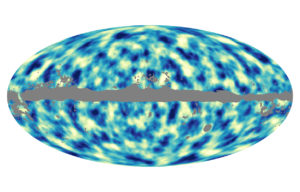
In the early 1970s, the American astronomer Vera Rubin studied the rotation of several nearby spiral galaxies, including the Andromeda galaxy. Rubin noticed that stars in the outer arms of these galaxies orbit their galactic centres faster than calculations would predict, based on estimates of the combined gravitational mass of all of the observable material within each galaxy.
In order to explain this discrepancy, theorists suggested that galaxies might actually contain much more material, by mass, than is directly observable to us as stars, gas and dust. This theoretical material became known as ‘dark matter’ – material that is invisible to us because it doesn’t interact with light, or any other part of the electromagnetic spectrum. It is currently believed that up to 90 per cent of a galaxy’s mass is in the form of a spherical halo of this dark matter, extending out far beyond the boundary of the galaxy’s visible disk of ‘luminous’ matter.
Astronomers do not currently know what this theoretical dark matter consists of. However, many candidates exist (see below), and, in the standard model of cosmology, dark matter is currently considered to account for around 27 per cent of the total mass-energy of the Universe. Ordinary matter accounts for only around 5 per cent and dark energy accounts for the remaining 68 per cent. Leaving dark energy aside, this means that around 85 per cent of the matter in the universe is in the form of dark matter.
Alternative theories, to explain the phenomenon, include proposed modifications to the known laws of gravitation. These theories suggest that gravity’s simple ‘inverse square law’ would need an additional term, which would make the gravitational interaction stronger than otherwise expected, over galactic distances. It should be noted that the need for a modified theory of gravitation has not yet been ruled out.
Possible Types of Dark Matter – MACHOs and WIMPs
A number of suggestions have been proposed for the composition of dark matter, which can generally be categorized as baryonic matter and non-baryonic matter.
Massive compact halo objects or MACHOs (referring to the ‘halos’ of dark matter that surround galaxies) are large objects composed of, or originating from, ordinary baryonic matter. This includes black holes, neutron stars, old white dwarfs that are now too dim to be easily seen, and brown dwarfs.
Baryonic dark matter might also exist in the form of unobservable gas and dust.
Alternatively, non-baryonic matter includes hypothetical particles such as axions, sterile neutrinos or unknown weakly interacting massive particles, known as WIMPs. WIMPs might possibly turn out to be supersymmetric particles that are predicted to exist by theoretical modifications to the standard model of particle physics. Axions are hypothetical elementary particle postulated to resolve the strong CP problem in quantum chromodynamics (QCD).
It is possible that dark matter is composed of a mixture of the two types to varying degrees; however, it is unlikely that the majority of dark matter is baryonic, since baryonic matter in the form of gas and dust would also be expected to be visible when backlit by stars, and MACHOs would be detectable due to gravitational lensing.
In addition to this evidence, the theory of nucleosynthesis in the Big Bang model (which predicts the relative abundances of the lightest chemical elements in the Universe) suggests baryonic matter accounts for only 4 to 5 per cent of the universe’s critical density – the minimum density that ensures that the Universe could not expand forever, but will not collapse back on itself under it’s own gravity. On the other hand, observations of large-scale structure in the Universe suggests that the total matter density is about 30 per cent of the critical density, suggesting that dark matter is mostly non-baryonic.
This also agrees with evidence from studying small anisotropies in the Cosmic Background Radiation, that around five sixths of the total matter in the Universe is in a form that only interacts significantly with ordinary matter or photons through the force of gravity.
Hot, Cold and Warm Dark Matter
Dark matter can also be divided into ‘cold’, ‘warm’ and ‘hot’ forms; however, this refers to the particles’ velocities relative to the speed of light, rather than their thermodynamic temperature.
Cold dark matter refers to objects or particles moving at lower velocities, such as MACHOs, WIMPs or axions. Hot dark matter refers to particles moving close to the speed of light such as neutrinos. Warm dark matter would have intermediate velocities and could possibly include sterile neutrinos and gravitinos.
The reason for classifying dark matter into hot and cold forms is mainly due to the effect on formation of structure in the evolution of the Universe. Theories suggest that cold dark matter leads to a “bottom-up” formation of structure, with galaxies forming first and then joining up to form clusters and super-clusters. Hot dark matter, on the other hand, should correspond to the formation of larger mass aggregates that surround whole galaxy clusters, resulting in a “top-down” formation scenario. The latter model has now been excluded by observation of high-redshift galaxies. Hot dark matter on its own, therefore, doesn’t seem to be capable of explaining the observed evolution of galaxies and galaxy clusters in the early Universe. Consequently, most research is currently focused on cold (or possibly warm or mixed) dark matter theories.